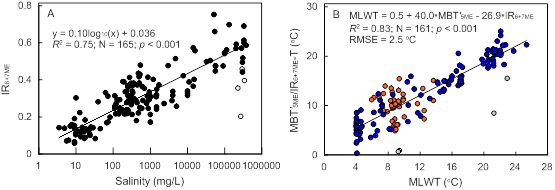The numerical parameterization of past climate, particularly temperature, is key to understand the evolution of the Earth's climate system and project future climate change.
Branched glycerol dialkyl glycerol tetraethers (brGDGTs), a suite of microbial molecular fossils ubiquitous in nature, are a novel temperature proxy for the geological past on continent. Factors other than temperature can also affect the distribution of brGDGTs in lacustrine systems, hampering the quantitative application of this paleothermometer.
Recently, researchers from the Institute of Earth Environment of the Chinese Academy of Sciences and their collaborators systematically investigated the environmental controls on brGDGTs in mid-latitude Asian lakes.
Combining with published data from other lakes across the globe, the researchers found a strong salinity control on the isomerization of brGDGTs. Salinity-controlled isomerization could impact the MBT′5ME paleothermometer, potentially leading to a significant overestimation of past temperature values.
Then they developed new indices based on the isomerization of brGDGTs for tracing past lake water salinity, as well as a novel method for correcting the salinity effect on the MBT′5ME paleothermometer
The new salinity proxies have strong linear correlations with salinity (R2 > 0.75) for the global lake dataset except for some hypersaline lakes with extremely low brGDGT productivity. On the other hand, the new temperature calibrations after accounting for salinity effect have root mean square errors as low as 2.4–-2.5 ℃ for global lakes.
This study, published in Geochimica et Cosmochimica Acta, would facilitate the simultaneous retrieval of reliable temperature and salinity records from global lakes that have experienced large hydrological changes.

Fig. 1 Geographical locations of studied lakes. The base topographic map is made with Natural Earth (https://naturalearthdata.com, and modified using ArcMap 10.5.)

Fig. 2. A. Relationship between brGDGT isomerization index (IR6+7ME) and salinity. B. The global calibration between lake water temperature and brGDGTs. (Image by WANG, et al)
Contact: Bai Jie, Institute of Earth Environment, Chinese Academy of Sciences, Xi'an, China. Email: baijie@ieecas.cn
 © 2015 Institute of Earth Environment,CAS
© 2015 Institute of Earth Environment,CAS Address:No. 97 Yanxiang Road, Xi'an 710061, Shaanxi, China

 Location :
Location :